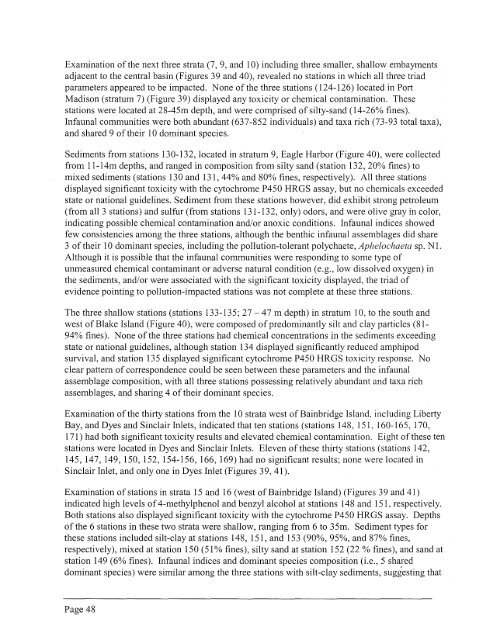Sediment Quality in Puget Sound Year 2 - Center for Coastal ...
Sediment Quality in Puget Sound Year 2 - Center for Coastal ...
Sediment Quality in Puget Sound Year 2 - Center for Coastal ...
Create successful ePaper yourself
Turn your PDF publications into a flip-book with our unique Google optimized e-Paper software.
Exam<strong>in</strong>ation of the next three strata (7, 9, and 10) <strong>in</strong>clud<strong>in</strong>g three smaller, shallow embayments<br />
adjacent to the central bas<strong>in</strong> (Figures 39 and 40), revealed no stations <strong>in</strong> which all three triad<br />
parameters appeared to be impacted. None of the three stations (124-126) located <strong>in</strong> Port<br />
Madison (stratum 7) (Figure 39) displayed any toxicity or chemical contam<strong>in</strong>ation. These<br />
stations were located at 28-45m depth, and were comprised of silty-sand (14-26% f<strong>in</strong>es).<br />
Infaunal communities were both abundant (637-852 <strong>in</strong>dividuals) and taxa rich (73-93 total taxa),<br />
and shared 9 of their 10 dom<strong>in</strong>ant species.<br />
<strong>Sediment</strong>s from stations 130-132, located <strong>in</strong> stratum 9, Eagle Harbor (Figure 40), were collected<br />
from 1 l-14m depths, and ranged <strong>in</strong> composition from silty sand (station 132,20% f<strong>in</strong>es) to<br />
mixed sediments (stations 130 and 13 1,44% and 80% f<strong>in</strong>es, respectively). All three stations<br />
displayed significant toxicity with the cytochrome P450 HRGS assay, but no chemicals exceeded<br />
state or national guidel<strong>in</strong>es. <strong>Sediment</strong> from these stations however, did exhibit strong petroleum<br />
(from all 3 stations) and sulfur (from stations 13 1-132, only) odors, and were olive gray <strong>in</strong> color,<br />
<strong>in</strong>dicat<strong>in</strong>g possible chemical contam<strong>in</strong>ation andlor anoxic conditions. Infaunal <strong>in</strong>dices showed<br />
few consistencies among the three stations, although the benthic <strong>in</strong>faunal assemblages did share<br />
3 of their 10 dom<strong>in</strong>ant species, <strong>in</strong>clud<strong>in</strong>g the pollution-tolerant polychaete, Aphelochaeta sp. N1.<br />
Although it is possible that the <strong>in</strong>faunal communities were respond<strong>in</strong>g to some type of<br />
unmeasured chemical contam<strong>in</strong>ant or adverse natural condition (e.g., low dissolved oxygen) <strong>in</strong><br />
the sediments, andlor were associated with the significant toxicity displayed, the triad of<br />
evidence po<strong>in</strong>t<strong>in</strong>g to pollution-impacted stations was not complete at these three stations.<br />
The three shallow stations (stations 133-135; 27 - 47 m depth) <strong>in</strong> stratum 10, to the south and<br />
west of Blake Island (Figure 40), were composed of predom<strong>in</strong>antly silt and clay particles (8 1 -<br />
94% f<strong>in</strong>es). None of the three stations had chemical concentrations <strong>in</strong> the sediments exceed<strong>in</strong>g<br />
state or national guidel<strong>in</strong>es, although station 134 displayed significantly reduced amphipod<br />
survival, and station 135 displayed significant cytochrome P450 HRGS toxicity response. No<br />
clear pattern of correspondence could be seen between these parameters and the <strong>in</strong>faunal<br />
assemblage composition, with all three stations possess<strong>in</strong>g relatively abundant and taxa rich<br />
assemblages, and shar<strong>in</strong>g 4 of their dom<strong>in</strong>ant species.<br />
Exam<strong>in</strong>ation of the thirty stations from the 10 strata west of Ba<strong>in</strong>bridge Island, <strong>in</strong>clud<strong>in</strong>g Liberty<br />
Bay, and Dyes and S<strong>in</strong>clair Inlets, <strong>in</strong>dicated that ten stations (stations 148, 15 1, 160- 165, 170,<br />
171) had both significant toxicity results and elevated chemical contam<strong>in</strong>ation. Eight of these ten<br />
stations were located <strong>in</strong> Dyes and S<strong>in</strong>clair Inlets. Eleven of these thirty stations (stations 142,<br />
145, 147, 149, 150, 152, 154-156, 166, 169) had no significant results; none were located <strong>in</strong><br />
S<strong>in</strong>clair Inlet, and only one <strong>in</strong> Dyes Inlet (Figures 39,41).<br />
Exam<strong>in</strong>ation of stations <strong>in</strong> strata 15 and 16 (west of Ba<strong>in</strong>bridge Island) (Figures 39 and 4 1 )<br />
<strong>in</strong>dicated high levels of 4-methylphenol and benzyl alcohol at stations 148 and 15 1, respectively.<br />
Both stations also displayed significant toxicity with the cytochrome P450 HRGS assay. Depths<br />
of the 6 stations <strong>in</strong> these two strata were shallow, rang<strong>in</strong>g from 6 to 35m. <strong>Sediment</strong> types <strong>for</strong><br />
these stations <strong>in</strong>cluded silt-clay at stations 148, 15 1, and 153 (90%, 95%, and 87% f<strong>in</strong>es,<br />
respectively), mixed at station 150 (5 1% f<strong>in</strong>es), silty sand at station 152 (22 % f<strong>in</strong>es), and sand at<br />
station 149 (6% f<strong>in</strong>es). Infaunal <strong>in</strong>dices and dom<strong>in</strong>ant species composition (i.e., 5 shared<br />
dom<strong>in</strong>ant species) were similar among the three stations with silt-clay sediments, suggest<strong>in</strong>g that<br />
Page 48







